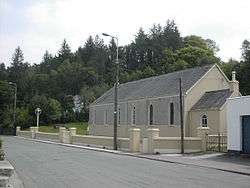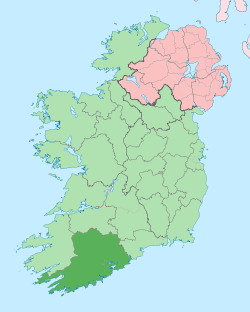Cúil Aodha
| Cúil Aodha Coolea | |
|---|---|
| Village | |
 | |
 Cúil Aodha Location in Ireland | |
| Coordinates: 51°55′41″N 09°13′07″W / 51.92806°N 9.21861°WCoordinates: 51°55′41″N 09°13′07″W / 51.92806°N 9.21861°W | |
| Country | Ireland |
| Province | Munster |
| County | County Cork |
| Cúil Aodha is the only official name. | |
Cúil Aodha (pronounced [ˈkuːlʲ ˈeː]), anglicised as Coolea,[1] is a townland and village in the Gaeltacht region of Muskerry in County Cork, Ireland. It is near the River Sullane's source, high in the Derrynasaggart Mountains.
Townland
Most of the inhabitants live on the south side of the valley. The townland itself is in Ballyvourney Parish and is an official Gaeltacht where the Irish language is used alongside English. The area is famous for its strong cultural tradition, especially within the field of music and song; Sean-nós. The village of Cúil Aodha is close to the new Wind Farms which are located on the mountains which mark the Cork and Kerry border. The land is mountainous and roadways are usually narrow lane ways which lead up the valley.
People
The Irish composer Seán Ó Riada lived in the area between Cúil Aodha village and Ballyvourney until his death and his son Peadar Ó Riada is currently conducting the famous choir Cór Chúl Aodha. In the summer of 2008 a bronze monument of Seán Ó Riada was erected near Cúil Aodha.[2]
Trade
Coolea cheese is produced in the area. The Mark Éire factory, which specialises in climate technology, opened in 1987 and is still operating its Irish Department out of Cúil Aodha village.[3]
Film
Both Song for a Raggy Boy directed by Ashling Walsh (2003) and The Wind That Shakes the Barley (2006) directed by Ken Loach were filmed in the area surrounding Cúil Aodha.
Transport
The area is rural and has a dispersed population around the valley. No bus service operates to the village. The nearest Bus Éireann route is the Cork to Tralee route which passes through Ballyvourney which is approximately 2 miles from Cúil Aodha village.
See also
References
- ↑ Placenames Database of Ireland
- ↑ Ó Canainn, Tomás. "Seán Ó Riada: His Life and Work". Collins Press, 2003. p 143
- ↑ Mark Climate Technology. Mark Éire Verified 2011-04-03.
External links
| Wikimedia Commons has media related to Cúil Aodha. |
